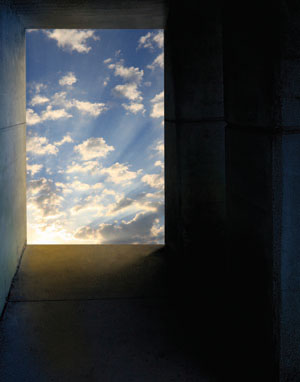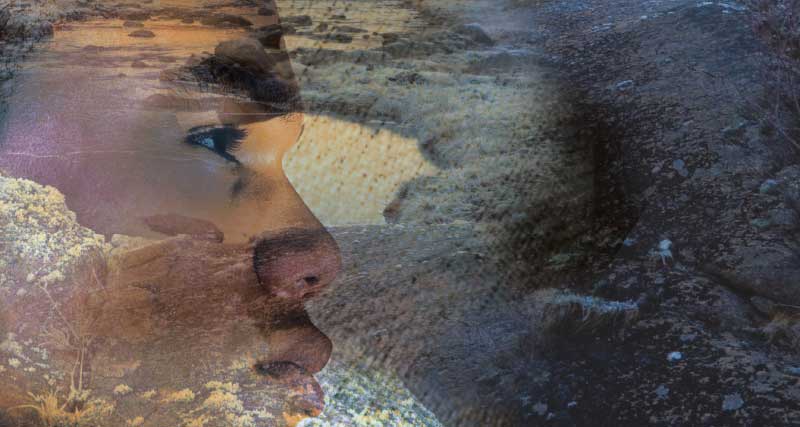Exploring our spirituality through metaphor
 A few years ago, while attending a retreat at Friends House in Barnesville, Ohio, and surrounded by Quakers from all over the country, I began to notice something peculiar about the way that people were speaking in meeting for worship. It did not seem to matter which branch of Friends the speaker came from; whether Orthodox, Liberal, or Conservative, each person spoke using metaphors. Being a student of sociolinguistics, I began to wonder if our common language habit could be metaphor. This conjecture led me into a yearlong study using linguistic theory focused on contemporary Quaker use of metaphor. My research aimed to compare the ways in which contemporary Friends and the early Friends of the seventeenth century embody their spiritual experiences using the classic metaphors of dark and light.
A few years ago, while attending a retreat at Friends House in Barnesville, Ohio, and surrounded by Quakers from all over the country, I began to notice something peculiar about the way that people were speaking in meeting for worship. It did not seem to matter which branch of Friends the speaker came from; whether Orthodox, Liberal, or Conservative, each person spoke using metaphors. Being a student of sociolinguistics, I began to wonder if our common language habit could be metaphor. This conjecture led me into a yearlong study using linguistic theory focused on contemporary Quaker use of metaphor. My research aimed to compare the ways in which contemporary Friends and the early Friends of the seventeenth century embody their spiritual experiences using the classic metaphors of dark and light.
Beginning with the twentieth century, a diverse religious population has been steadily arising in Quaker meetings, including many non-Christians. Thus, the traditional meanings of the dark and light metaphors, which are rooted in biblical passages, have been changing. Many newcomers have joined the Religious Society of Friends after walking away from other Christian churches. They were resisting other church discourses about the Bible. In the past few decades, Friends have been adopting new identities and renaming themselves in a multitude of ways, using terms such as Neo-Pagan, nontheist, or post-Christian. Some Christian Friends have been reacting with fear and anger to these names, asking an anxious question: is Christianity being lost in the twenty-first century?
Over the past 13 years, as I journeyed among Friends as a traveling minister, I have directly experienced worship in the Conservative, Liberal, Orthodox, and Evangelical traditions. At times I detected some fearfulness by Christians of the loss of the traditional metaphorical meaning of the Light, namely that the Light is Christ. I began to wonder: is this changing language drawing us together or keeping us apart?
To me the beginning of the Quaker story is George Fox’s startling question, “What canst thou say?” With this question, he invited seventeenth-century Seekers to live “experimentally” and not rely solely upon the experiences of others through the scriptures. For more than 350 years, amidst many cultural changes and through a constant evolution of beliefs and practices, the Friends have held tightly to this principle of embodying their spirituality through metaphor.
The word metaphor is rooted in two Greek words, meta for “over” and pherin for “to bear or carry.” Thus metaphors are used as a way of transferring meaning from one frame of reference to another. As the original metaphor changes, it is capable of creating new understanding and realities. While engaged in my linguistics studies, I learned of this concept of embodiment of spirituality through sensorimotor experience from philosopher Mark Johnson. I perceived that this idea of embodied spirituality fits neatly into the Quaker method of worship, which involves human interaction with the spiritual world through a constant metaphorical process. Quakers in waiting worship are seeking the words to express their mystical experiences. New metaphors are still being constructed as some contemporary Friends seek to express their spirituality using such naturalistic terms as sunlight and photosynthesis.
A few years ago, I discovered evidence of a remarkable example of these metaphors in contemporary use at Live Oak Meeting in Houston, Texas. They have built a new meetinghouse following a traditional architectural design of simple wooden benches arranged in quadrants facing the center of the room. At the center point of the ceiling is Skyspace, an unobstructed window open to the sky, designed by the Quaker artist James Turrell. Skyspace, when opened at dawn and twilight, offers Friends and neighbors a chance to physically experience darkness-into-light and light-into-darkness. When asked where he got this idea, Turrell says that as a child his grandmother took him to silent meeting. When he asked her to explain what they were doing, she replied, “Turn inward to greet the Light.” And he says to himself, even to this day, “I wonder what it means.” I too find myself wondering what contemporary Friends mean when they speak of the Light.
What do contemporary Friends mean when they speak of the Light?
Lately I have been listening deeply to James Nayler, a seventeenth-century English Friend and traveling minister, who is probably best known for his fall into the darkness and eventual emergence into the Light at the end of a painful imprisonment. Here in this message, he calls us to consider the interplay between light and dark:
Art thou in the darkness? Mind it not, for if thou dost thee will feed it more. Stand still, act not, and wait in patience till light arises out of darkness and leads thee.
Nayler calls us to stand still in the Light, to wait for a leading out of darkness. His message speaks to us as a process of transcendence from our darkest selves that can lead us into the Light. In Nayler’s time, the Light metaphor could only have meant the Christ-light, but contemporary Friends are experimenting, as Fox advises them, in their spiritual expressions.
For my research project, I interviewed a Quaker who calls himself a Neo-Pagan. His childhood training was in the Episcopal Church. When I asked him if he would still call himself a Christian, he replied, “In fact, one of the things Quaker-Pagans have said quite out loud is that the people who understand us in the Society of Friends are the born-again Christians because Pagans, on the whole, will talk about immediate experience.” He also related that he has had interactions with Jesus and the Christ-light, but does not worship him. At one point in the interview, I commented, “Your interactions with Christ are quite personal and they are real.” He responded, “Yes, although I would say Christ doesn’t have a persona. For me, Jesus of Nazareth and Christ, although they are joined, are separate entities. So the Christ-light, it is a light. It’s not a personhood or a person or even a god or a goddess. It might be an archetype.” This interaction taught me a great deal about the process of conceptualizing the Light and how it can transfer meaning through the person’s own individual experience.
The following quotation was taken from an article sent to me by a Liberal Friend named David, who is using natural light as the context and image for light and dark metaphors.
And what I’ve been seeing in recent dawn watches is that the “light of day” does not burst upon us with suddenness. It’s a peculiarity of our planet having an atmosphere which diffuses light, that we have this gradation from darkness to illumination and then reversing again in the evening. Were we on the moon, it wouldn’t be at all like that. It’s all or nothing; Bam! Suddenly. No moderation of transition. My circumstances somewhat recently have had me frequently awakening with some sense of heaviness, of dread, of anticipated failure, occasionally of pessimism or sourness. That is not a good place to be or where I want to be, but I must admit that the feeling tone is a negative one, and it claims in those moments to be my reality. And here is where the gradual, gentle, ever-so-subtle working of the Light comes to me.
David’s use of astronomical descriptions to contrast his moods helps him to describe the light coming into the darkness, slowly illuminating his mind and lifting him from feelings of despondency. I find that his thoughts mirror Nayler’s, who is also speaking of waiting for the Light. Both speak of the subtle workings of the Light to raise them up and lead them away from the darkness of sad feelings.
Another interview was with Cathy, a young adult Friend, whose family has been Quaker ever since they arrived in Pennsylvania with William Penn. Although she told me that she has not been taught directly about early Friends writings, she evidences an intuitive understanding of the classic metaphors and how they work.
I don’t really get much darkness when I meditate. I describe it as a strength, and I guess the strength could be a light growing out of the darkness, coming into the light. It’s not going into the darkness, maybe accompanying in the darkness. God is helping me in the darkness when I am meditating.
I wonder if this metaphorical transition she describes of the light and dark working together is somehow transmitted in our Quaker DNA. Many of us who were trained in other Christian churches were taught that dark equals evil, light equals good, and sin is inescapable. But the early Friends in their unusual linguistic style emphasized that the Light is a searchlight that shows where change is needed. This view is perhaps more like seeing yourself, similar to the way that psychologist Carl Jung described “the shadow” to mean the unadopted or hidden side of one’s self. George Fox did not deny the darkened nature of humanity; instead he offered people a way out, saying:
Keep the testimony of Jesus, the sight of Jesus, your prophet . . . the sight of him who is your Leader out of death into life, out of darkness into light.
Fox points toward a new way, a meaningful process of examining and removing condemnation from the spiritual path.
The next quote is from Mariellen, who has suffered from long-term mental illness as an adult. She has a unique way of using the Light to offer her hope when she feels captured in the dark recesses of her mind:
During a very dark time in my life, I could use a variation of the Light metaphor to convey to others my sense that God was with me even in those very dark times. I wrote a poem in which I used the phrase, “faint starshine in deepest darkness,” to convey, actually, two things: first, that I was not alone, and second, that it was my responsibility to watch for and respond to the faint starshine.
In her darkest days, Mariellen relied upon the metaphor of light to encourage and support her return to health. She saw a light that guided her back home much as the early Friends saw light in their dark dungeon cells.
Finally, here is a quote from an interview with Tim, an Orthodox-Conservative Friend, a Christian. He is speaking here of the Light as an agent of change for his spiritual journey:
I like that contemporary quote, “Live up to the light thou hast.” The more one experiences living up to the light, the more one experiences endeavoring to try to walk in that light, to live up to that guidance; hopefully the more refined one’s sense will become, the better one will become in discerning the light and its promptings. And likewise the opposite is true, if you ignore that light, there is the danger of backsliding all the more into the ocean of darkness. The name of the game is wanting to become the person Christ intends you to be. This metaphor, this mechanism, really resonates with me to achieve that. It’s an ongoing journey. We are marching to Zion. We are not there, so we need light every day.
Tim refers to the classic Fox quote about the ocean of light and the ocean of darkness, which are always together. Darkness cannot be without light, and light cannot be without the darkness. These metaphors are still in use; the meanings are expressed in different ways, but the mental process of embodying spirit through language has never changed. We are still living experimentally.
As asserted by early Friend Isaac Penington Jr. (1616-1679), “the names are but the signification of the thing spoken of, for it is the life, the power (the being transformed by that) that saves, not the knowledge of the name.” It is not the name itself (the metaphor), but the power it represents that has greatest significance to Friends. It is from this commonly held understanding that the use of metaphors has taken root as a form of religious expression among Friends. The practice of sitting in communal silence in meeting for worship encourages the transfer of spiritual meaning when messages are spoken in metaphor as a form of shared wisdom.
What have I learned? First of all, the challenge of George Fox and early Friends to seek direct experiences in worship is still actively pursued among contemporary Quakers. But my most important lesson has been to approach any Quaker’s spiritual story with a question. I wonder what each person means, and I listen more deeply to his or her answer. I have a newfound respect for the evolution of an individual’s spirituality no matter which label he or she may be choosing to wear at the moment. As Fox said, “What canst thou say?”






It’s tempting to look at light and dark solely as a personal spiritual issue. There is also a lot of darkness in our public political life today. Too many of our leaders do not want to think outside their political dogmas, or acknowledge the consequences of those dogmas. One way, perhaps, to create more light is to keep an eye out for allies, spiritual and otherwise, in other religious groups (Mennonites, mainline churches, Sojourners, even Buddhists and Muslims) and secular groups like the ACLU and Move On.
I deeply appreciate this beautiful article by Maurine. My one edit? “Friends have been adopting new identities… using terms such as nontheist…” But I feel that I, and many others I my generation of Friends, didn’t adopt this framework, we were raised this way.
For me, it’s not exactly accurate to suggest I declare nontheism as a new identity. Raised a Midwestern Friend, I identify as a nontheist because that’s the only Quakerism I’ve ever known as my own.
ExperieThe problem with metaphors based on experience is that there are different levels of experience, and the metaphor can be interpreted on each level. For example with light and darkness:
1. The physical realm.
2. The mental realm – the world of math, poetry, dreams, daydreams and visions.
3. The spiritual realm – “experimental” (18th c.) or “experiential” (21st c.)
These realms are all, as Jesus said, “at hand” (not “coming soon to a church or synagogue or meeting house near you”). They are all dimensions of “right here” and “just now”, and as dimensions, they coexist and interpenetrate. Thus experiences in life or in a meeting can simultaneously be on one or more level.
Experiences of the physical realm can be shared. We can agree that a particular apple is red, without any assurance that we perceive ‘red’ in the same way (for example the color blind). We can attempt to describe a dream, daydream or visionary experience, but this is more tenuous. But in the realm of spirit, we attempt to speak of a reality which is not commonly experienced and seldom shared in our culture. It is extremely difficult to be sure we are talking about the same thing, because it is not one of the five commonly accepted senses. We do not have a common language for it. The best we can do is attempt to name it by metaphor. But as the Tao Teh Ching says, “the name that can be named is not the real Name.” Any metaphor we use for spiritual experience can be misinterpreted by those who do not share that experience, as merely pertaining to the realms which they do experience. I speak spiritually, they interpret mentally or physically, and do not understand.
So why do we use the metaphor of ‘Light’ when speaking spiritually? Because we are speaking of a felt sense. It is not like looking at a candle or the bright sky. It is more like the sense of our body sunbathing in dark sunglasses with our eyes closed. We feel the radiance of the sun through the translucent flesh of our whole body (other than our eyes).
Spiritually we have a felt sense of holy radiance which is potentially received through the perceptual field of the heart. As children we tend to shut down this field because of the unbearable grossness of much of our experience of the world (darkness). Spiritual growth requires a re-education of the perceptual field of the heart, which is more easily accomplished when one is in an environment of mutual safety, where others are experiencing that which we seek to discover. I have experienced this sense of radiance in diverse religious group settings, and expect that it is available when Friends/Quakers sit in silence together. I would expect there to be a strongly available felt sense in such gatherings which is independent of any words which are spoken, and which is perceived by many of the participants.
And the words? “Faith comes by hearing.” The words may suggest ideas or concepts which ease the path for the mind. But when a person whose heart is deeply experiencing the spiritual radiance of the gathering speaks, their words may carry the resonance of that radiance to others in the room. What is spoken from the heart goes to the heart, and may help to awaken the heart of another. When such a person uses a metaphor for the experience, some may only seek to interpret the metaphor intellectually, while others sense the radiance of the experience in the quality of the voice which speaks the metaphor.
This hearing is not the superficial hearing of the ears and mind. It comes from deep listening, listening from the core of our being. “Shema Yisroel, YHWH eloheinu, YHWH ehod.” We are listening to the divine presence of YHWH, a name which cannot be spoken, because it denotes an experience of YHWH which is available to those who listen deeply in silence. And it continues to be available when all the possible words which can be spoken or written about it have been used, and the pure and radiant silence returns.
Yes, I am passionate about the language of Friends. Having traveled widely among
the many branches, I have always felt there was a unity beneath the disputes
over theological difference. We are seekers, and our language is metaphor.
It always felt to me like we were extended family members who forgot
to stay in touch. Even though as Americans we have branched out, we still come
from the same root. I will continue my research with a book about the
use of Quaker metaphors by young Friends who have been raised in
Quaker families. I am further testing this proposal that the peculiar people, the Friends,
have their own peculiar spiritual language – metaphor.